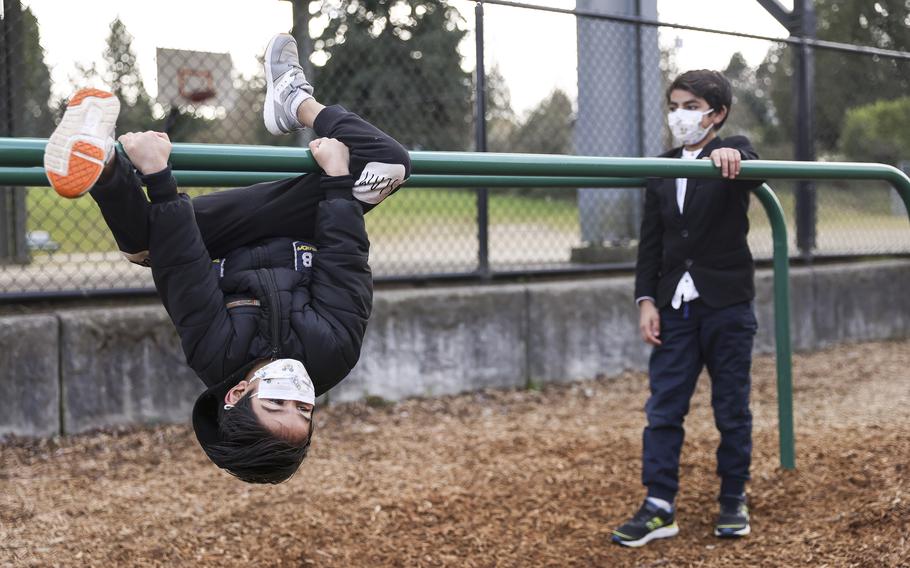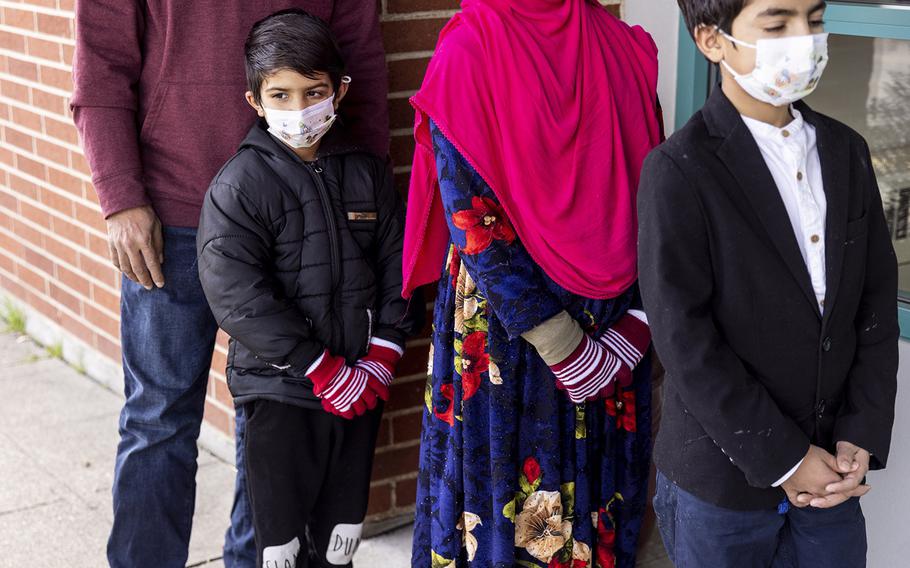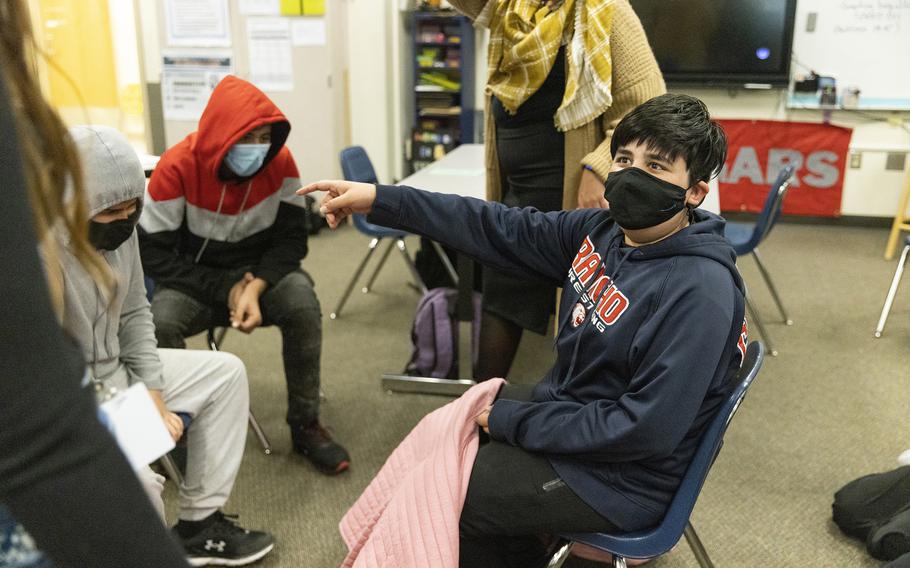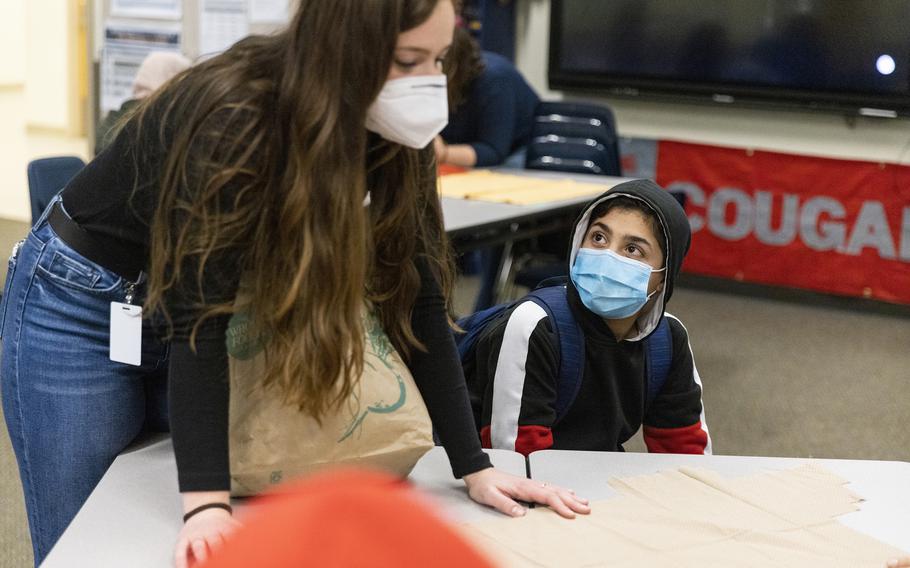
Brothers Mirwais, 7, and Awais, 9, run around the playground at their new school, Southern Heights Elementary, as they get a tour on Feb. 16, 2022, in Burien, Washington. (Amanda Snyder/The Seattle Times)
SEATTLE (Tribune News Service) — They lined up at the doors of Southern Heights Elementary in Burien, momentarily subdued as they waited for their first glimpse of American school. Awais, 9, in a sharp black blazer and white shirt, led the way, followed by Fazilat, 10, in sparkly pumps and a bright pink headscarf, and 7-year-old Mirwais, his father’s hands resting on his shoulders.
The three Afghan siblings, among one of the largest waves of refugees to come to the U.S. in decades, had waited for this moment since flying out of Taliban-controlled Kabul in August. They spent four months on a Texas Army base and arrived in the Seattle area in December. “We’re so excited you’re here!” principal Andrea Smith told them, giving a tour in advance of their first day. She had them choose from an array of donated backpacks, showed them a room where they could pray and told a class of students: “I know you guys will be there to help.”
The little school, with just over 200 students, including a large number of native Spanish speakers, did not have an interpreter on hand. But a custodian who emigrated from Afghanistan in 2019 surprised them by saying hello. Speaking a mixture of Pashto and Dari, Afghanistan’s primary languages, Abdul Bakhshi reassured the children’s dad that they would learn English as his own kids did.
As the siblings hit the playground, Ally Nguyen, part of a group of volunteers helping the family resettle, told the principal the children hadn’t consistently attended classes in two years. Their school in Afghanistan largely shut down when COVID-19 hit.
“We’ll get them where they need to go,” Smith said.

Mirwais, 7, left, and his family wait outside their new school, Southern Heights Elementary, where they will take a tour of the grounds and classes, on Wednesday, Feb. 16, 2022 in Burien, Washington. (Amanda Snyder/The Seattle Times)
It’s a shared mission among schools seeing an influx of Afghan students — and which may soon see a whole new group of refugees arriving from the war in Ukraine. Schools are having to quickly think through what these kids need, which means understanding not only their academic background but what they’ve gone through to get here.
“You have children coming with more trauma than we can ever put words on,” said Emelie Coffman, manager of the children and families program for the resettlement agency World Relief Seattle.
The Seattle area is one of the top destinations for families fleeing the Taliban after the fall of Kabul last summer, drawn by a sizable Afghan community already here. Roughly 6,000 people born in Afghanistan lived in Washington as of 2019 census data, many given special immigrant visas because of their work for the U.S. government. About 2,900 more have come since late September after a stay on American military bases, according to state Refugee Coordinator Sarah Peterson.
Many got separated from loved ones — spouses, parents, children and siblings — in the chaotic crowds at the Kabul airport. Family members left behind are inevitably on the minds of newly enrolled Afghan students.
They are arriving with varying levels of education. Some, especially those who lived in cities, attended school fairly regularly while others literally not at all. If their fathers worked with the U.S. military, leaving home could be dangerous.
Local schools have welcomed these students enthusiastically. Some districts have also been hiring or expanding the work of Pashto and Dari interpreters, adding after-school and other extended-learning programs for refugees, buddying new Afghan students with ones who have lived here for a while, and training staff about the needs and experiences of these students.
“It’s been necessary for us to really mobilize,” said Peter Lamb, a coordinator of multilingual programs for the Auburn School District. While the district has had an array of refugee students come in the past, including from Somalia, Kenya, Iraq and Afghanistan, what’s different now is having many such students, more than 100, come virtually at once, noted his colleague, Maeghan Bowman.
In the Kent School District, an interpreter who has taken on a larger role has even helped Afghan families get food stamp cards, said Kinder Garcha, the district’s refugee service liaison. Some refugees have resettlement agency caseworkers and others, having opted to leave bases on their own, don’t. They may need extra help either way, the district is finding, because resettlement agencies, scaled back during the Trump years, have been overwhelmed by the mass arrival of Afghan refugees. And large numbers of refugees from the war in Ukraine haven’t even arrived yet.
For all the effort, many schools don’t have enough resources for these kids, such as interpreters and mental health support, said Coffman of World Relief. The students get English-language instruction, but generally not by someone who speaks Pashto or Dari, and they also take regular classes where they can’t understand a thing, she said. Districts that have Afghan-language interpreters tend to have just a few, working with families.
Given what these kids have been through, Coffman said the unmet need is “absolutely heartbreaking.”
In a World Relief training for teachers, she heard about a Kent middle schooler who would freak out when a fire alarm drill went off. The student would run to a younger brother and refuse to go, or let his brother go, to a field where everyone was supposed to gather.
“He got in trouble for that,” Coffman said. What school staff didn’t realize at the time was that the alarm, to a child raised amid war, signaled trouble and he had been taught not to go onto fields because of land mines.
‘We have an opportunity now’
A couple weeks after starting school at Carl Sandburg Elementary in Kirkland, two Afghan siblings, a 9-year-old boy and 6-year-old girl, were in some ways doing well.
“I just want to say what a sweet and observant girl [she] is and how eager she is to learn,” the girl’s teacher wrote to a volunteer who has been helping the family and acting as a liaison with the school. (The children’s mom, like many Afghan refugees, asked that she and her children not be named because of risks to family members back home.)
“I’m seeing that she is quick to pick up on what the other students are doing, especially if it’s something she can copy or imitate. Naturally, when I am giving direct instruction and the students are sitting and learning about a new concept, that is where I see [her] want to get up and go do something else.”
The boy has made a friend and has a special handshake with the physical education teacher. While there are no Afghan language interpreters at school, a Farsi-speaking staffer has been able to communicate some with the family. (Farsi and Dari are both Persian dialects.) In the sleeve of a school library book the boy brought home one February day, the staffer tucked a note in Persian script explaining the book must be returned.

Abdullah plays a game with students at the after-school program for refugee children, run by the resettlement agency World Relief, at Mill Creek Middle School in Kent, Washington, on Tuesday, Feb. 15, 2022. (Amanda Snyder/The Seattle Times)
Asked how he likes school, though, the boy talks instead about his dad, who had been beaten and pulled away from his family at the Kabul airport. “Save yourself and save our children,” he told his wife. “I will find a way to get out.” But the father is still in hiding, awaiting a humanitarian parole visa he has applied for.
On this day, the boy said through an interpreter he had dreamed the night before that “the Taliban were killing my dad.”
When he woke up, according to his mom, the 9-year-old asked if they could all go back to Afghanistan. “At least we’ll die together,” he said.
The children “can’t concentrate at school because day and night, their father is in their heads,” their mom said, weeping at times.
An Afghan mother of eight who now lives in Burien has already lost her husband. He was the victim of a suicide bomb last summer while working with U.S. forces. His work put the children at risk too, with kidnapping common. School was a long walk from their home on the outskirts of Jalalabad. So the children mostly stayed home. Even the oldest, 15- and 13-year-old girls, have never been to school, and have not learned to read.
“I really want the kids to go to school,” said their mother, who herself had only a few years of schooling because the education system in Afghanistan has been unstable and because the Taliban restricted education for girls when she was growing up. “They have wasted their life,” she continued. “We have an opportunity now.”
In the view of Ismail Khan, who was interpreting for her, it was taking too long to get the children enrolled. They had been in the Seattle area for a month and a half. Like many new arrivals served by overworked case managers in one of the most expensive housing markets in the country, the family was still in temporary housing, albeit a nicely furnished rambler. That meant they didn’t know what school district they would be in long-term.
The family moved to a permanent home in Auburn a couple weeks later and the kids started school, according to Khan, who emigrated from Afghanistan in 2014 and recently founded Afghans of Puget Sound Alliance to help those coming now. Yet, other Afghan children remain in limbo, he said.
Khan acknowledged school wasn’t going to be easy for children with limited or no education, and he plans to recruit volunteer tutors.
The results from just a couple months of tutoring can be seen around the corner from the widow’s home, where Fazilat, Awais and Mirwais live, along with their parents, baby sister and older siblings.
The family is one of eight from Afghanistan that are being resettled by groups of volunteer sponsors affiliated with Viets for Afghan, a largely Vietnamese-American organization that also includes Afghan immigrants like Khan. The U.S. government rolled out a “sponsor circle program” last year, meant to take some of the load off agencies, although this particular family is not part of the official program.
In addition to enrolling the kids in school, taking them to doctors visits and many other tasks, Nguyen, part of the group supporting the family, has been working with the children on English and basic math. In notebooks, the children have copied English words from a book in neat handwriting and spelled out their names. When a guest comes to their home, in the bottom floor of a split-level where the kids share a room decorated with a big American flag and tea is served at every opportunity in a sitting room encircled by cushions, the children eagerly respond when asked in English for their names.

Abid, right, listens to instructions from Brielle Cosgrove, a World Relief Seattle staffer, during a new after-school program for refugee children, run by the resettlement agency World Relief, at Mill Creek Middle School in Kent, Washington, on Tuesday, Feb. 15, 2022. (Amanda Snyder/The Seattle Times)
The children attended school before COVID hit, but the instruction was not good, the teachers frequently absent and classes noisy and crowded with as many as 100 students, according to the kids and their father, Sahibzada. After their first day at elementary school the week after their tour, Fazilat and Awais said they were struck by the quiet.
“The school is better,” Fazilat said through an interpreter. “I like everything,” Awais said.
“I know the first year will be a little challenging,” their father acknowledged, but added he was confident after that “they will be OK.”
In educational circles, there is an acronym for students who have had little schooling — SLIFE (students with limited or interrupted formal education) — but little data on how they do once they start going regularly, according to Chris Chang-Bacon, an assistant professor in the University of Virginia’s School of Education and Human Development. What data there is suggests such students have a high dropout rate.
“We do find that their success is largely determined not by the students themselves but (by) how well the school is set up to receive them,” Chang-Bacon said. Strategies that help, he said, include access to bilingual staff and community members, ideally ones who speak the students’ language; support in English; teachers used to working with students at different levels; and flexibility to allow students to learn in different ways, for example by allowing them to research projects in their own language.
An after-school program for refugee students at Mill Creek Middle School in Kent, run by World Relief, offers hope. Two students from Afghanistan said they were earning mostly A’s and had been moved from English-language learner classes into mainstream ones for English-language arts.
Tawqir, a seventh grader who has lived in the U.S. for three years, said he didn’t understand much at first. “We find Afghan friends and they tell us what to do,” he said. With Kent a center of Afghan-American life, the district has as many as 1,000 such students from Afghanistan, estimates Garcha, the refugee service liaison.
Eighth grader Hadia, only six months in the U.S., praised her kind teachers, one of whom uses his phone to translate words she doesn’t know. She appears to know a lot, though. An activity this afternoon involved students looking at pieces of cloth and saying what it reminded them of.
“Afghanistan,” Hadia called out, looking at a red cloth speckled with green flowers. “Green is peace,” she said. “Red is like the war.”
———
©2022 The Seattle Times. Visit seattletimes.com.
Distributed by Tribune Content Agency, LLC.